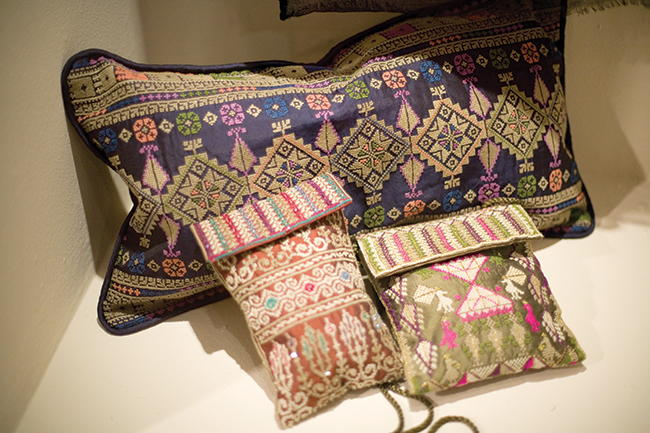
Among the turmoil and tragedy of present Palestinian existence, the beauty of Palestinian embroidery is like a ray of light that brings a smile to most people’s faces. Whether one is living in Palestine or anywhere else around the globe, it is a source of great pride and joy that one incorporates into one’s life, whether as pillows and wall hangings to decorate a home, a traditional dress to wear at special parties, an elegant evening jacket, or a priceless gift to give a friend. As old workshops and young designers find new ways to introduce Palestinian embroidery into elegant modern wear, the survival of this precious heritage is perpetuated and strengthened.

Although some individual features of Palestinian costume and embroidery are shared with aspects of textile arts of neighboring Arab countries, the Palestinian style has its special uniqueness that is easily recognized by textile art enthusiasts all over the world. Most books on international embroidery present Palestinian traditional costume and embroidery as the prime example of Middle Eastern embroidery, affirming its worldwide fame.
How did this art form develop? Actually, a study of the development of the traditional Palestinian costume through the ages proves that this traditional costume contains historical data that documents centuries of textile-art development in the region, an art form that has somehow amazingly survived to this day. Whether one studies the ancient traditional simple cut of the thobe, the history of the headdresses and accessories, the amazing variety of styles of embroidery, the types of stitches, or the ancient origins of its patterns and motifs, one is deeply impressed with the historical richness of this legacy that dates back thousands of years, and which affirms the antiquity of Palestinian existence and roots, and the survival of its ancient heritage.
The Palestinian Heritage Foundation
Farah and Hanan Munayyer began collecting Palestinian ceremonial costumes in 1987. In 1992, they founded the Palestinian Heritage Foundation (PHF), a cultural and educational non-profit organization that aims to promote awareness and understanding of Arab, and specifically Palestinian, culture and traditions. Their collection of over 3,000 items now includes traditional costumes, accessories, and art from all regions of Palestine and other Arab countries. Exhibits of this collection have been presented at over 20 museums, galleries, and major universities in the United States and Canada. Presently, PHF is exhibiting some of its collection at the newly inaugurated Bethlehem Museum in Bethlehem, Palestine.
Some of the patterns, headdresses, and robe styles are seen in engravings that go back to 1200 BC or statues from the first, third, or sixth centuries AD, with a constant continuity of style over numerous centuries to the present. And from a strictly aesthetic point of view, if one looks at a bridal dress from the early-twentieth century – the mix of stitches (fallahi, tahriri, or erk-al-loz) embroidered in silk in an exquisite blend of natural dyes often accentuated with appliqué, beads, and coins – one discovers a masterpiece of incredible beauty.

It is well known that Palestine had distinct regional styles, each unique to its area, which was the “badge of identity” for its wearer. At a marketplace or festival in the 1940s, it was easy to distinguish the lady from Ramallah, Al-Khalil, or Majdal from the other ten regional styles that existed. For the relatively small size of the country, this diversity is amazing. Within one region, all its members shared the same style, independent of religion. The “badge of identity” was therefore the regional identity as defined by the style of traditional dress worn in that region, irrespective of religious affiliation. All over Palestine, the same traditional regional style was worn by women of both religions, as seen, for example, in Bethlehem and Artas, or Ramallah and Al-Bireh. Throughout Palestine, this silent yet highly expressive assertion of social unity and identity among the two religious groups, as demonstrated by wearing the same regional dress, is very significant and remarkable.

The beauty of the Palestinian costume style had its influence on Europeans starting from at least the tenth to twelfth centuries AD, during the Crusades. Arab styles were copied in Europe, as documented by several European historians. The strong trade between the Arab world and Europe during the thirteenth to the sixteenth centuries AD, during the European Renaissance, was another example of the spread of Arab textiles and embroidery to Europe. This resulted in Arab embroidery patterns being copied into European pattern books starting in 1523 in Germany, using the newly discovered printing press, and spreading quickly through translated versions to Italy, France, and England. Starting from the eighteenth century, Europeans touring the Middle East described the beauty of Palestinian costume and embroidery, and took embroideries back home as souvenirs, considering them religious artifacts from the Holy Land. In his book History of Folk Cross Stitch (1964), the historian Heinz Kiewe presents a chapter on “Ancient cross stitch symbols from the Holy Land,” in which he confirms his “belief in the common, Palestinian source of these designs” used in European folk embroideries, because the patterns used in Palestinian traditional dresses were considered of religious significance and copied into European folk embroidery over the last several centuries for that reason. He mentions, for example, basic Palestinian patterns such as the eight-pointed star and reesh(feathers), whose acquired European names became Holy Star of Bethlehem and Holy Keys of Jerusalem. Kiewe also mentions the transfer of Palestinian embroidery patterns to Europe by St. Francis of Assisi and their use in church embroideries, which were recopied in the nineteenth century by the embroidery workshops of Assisi, whose embroidery style became famous throughout Europe. In the early-nineteenth century, several European missionary groups collected Palestinian costumes and embroideries for display in Europe, usually for church exhibits. These collections eventually found their way into important European museums and represent some of the oldest extant pieces of Palestinian embroidery.
Hanan Karaman Munayyer is the author of the widely acclaimed book Traditional Palestinian Costume: Origins and Evolution (2011). In a review about the book, Prof. Walid Khalidi had this to say: “This is a work of passionate commitment and unstinting dedication. Its comprehensiveness, density, elegance, and sheer beauty are a tribute both to the subject and the author. Future generations will remember her for the monumental achievement.”

As for the present new era of Palestinian embroidery, there is an overwhelming variety of innovation being created for the modern market, and much of it is of superior quality. However, some workshops mix foreign patterns copied in the 1950s from worldwide sources, not realizing that these patterns have very little to do with Palestine. If the Palestinian tradition is to survive, the old Palestinian patterns should be utilized in a modern context; the old costumes, with their variety of stitches, fabrics, colors, and beading, are an incredibly rich source of ideas for modern designers, as they innovate and conserve tradition at the same time. Using foreign patterns minimizes and negates the importance of the ancient patterns, and gives ammunition to the fake historians who mistakenly claim that most Palestinian embroidery patterns are copied from European pattern books, as published in some recent embroidery books. Although Palestinian embroidery has to modernize to stay alive, it should always keep the uniqueness of its style by using the old patterns, variety of stitches, and color combinations. Working with young designers and workshops to encourage these ideas, I get great satisfaction when they tell me that looking at old dresses and embroidery pieces have inspired them to create new items for modern wear while preserving the old appeal of the traditional style.
Is it then a wonder that their traditional embroidery is the source of so much pride among Palestinians? It has always been a language of beauty used to communicate both within the society and with visitors and societies abroad. International museum exhibits of traditional Palestinian costumes are some of the best ambassadors to the world, communicating a wealth of positive cultural information to audiences whose only knowledge of Palestine is usually of war images and violence. More of such beautiful cultural images of Palestine are needed to counteract the negativity faced by Palestinians every day.
 Hanan Karaman Munayyer, a Palestinian-American, is co-founder and president of the Palestinian Heritage Foundation. She is the author ofTraditional Palestinian Costume: Origins and Evolution, published in 2011 by Interlink and awarded Book of the Year by Foreword Reviews. She has researched and lectured on Palestinian textile arts for over twenty years. She is also a retired molecular biologist who worked in pharmaceutical research for more than three decades.
Hanan Karaman Munayyer, a Palestinian-American, is co-founder and president of the Palestinian Heritage Foundation. She is the author ofTraditional Palestinian Costume: Origins and Evolution, published in 2011 by Interlink and awarded Book of the Year by Foreword Reviews. She has researched and lectured on Palestinian textile arts for over twenty years. She is also a retired molecular biologist who worked in pharmaceutical research for more than three decades.
written by Hanan Munayyer and featured in This Week In Palestine October 2015 issue.
